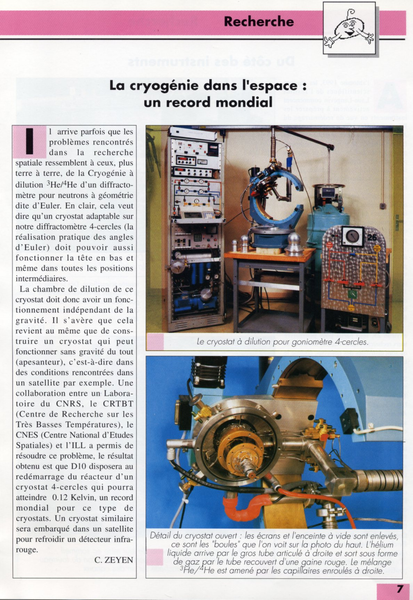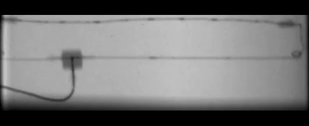Helium flow
 (png - 370 Ki)
(png - 370 Ki)Cryogenics system using a jet of nitrogen gas on LI4, a single-crystal X-ray diffractometer (AED Siemens), one of the very first scientific instruments at ILL.
©1972 ILL
Helium-flow cryostats
Liquid helium bath cryostats cool the sample essentially by conduction, but this poses several problems:
- the X-rays from sources of pre-synchrotron times were not strong enough to cross metal walls.
- bath cryostats are inadequate if the sample has to be moved in different directions, as in single crystal diffraction measurements.
The simplest solution in these cases is to shower the sample with a gas or cold liquid.
In the early days a jet of cold nitrogen was used for low-temperature X-ray measurements but these were limited to 100 K (-173°C). This method couldn't generally be used with helium since it is much colder (4 K) and much more expensive.
However the exceptional capacity of neutrons to penetrate most metals made it possible to let walls in the beam while this hadn't been possible with the weaker X-ray sources of pre-synchrotron times. The ILL was therefore very well positioned, as it could offer scientists a much wider range of temperatures together with very high neutron flux.
1972 - D10 at the start of ILL, down to 20 K
As neutrons have an excellent ability to penetrate common metals, it became possible to let metal walls in the beam; this hadn't been possible with the weaker X-ray sources of pre-synchrotron times.
Gérard Claudet and Armin Tippe [1] lost no time in taking advantage of this by building an original helium flow cryostat for the four-circle neutron diffractometer D10, before even the first neutrons came on line; the cryostat was designed to function despite complex movements of the sample.
The cold head was fed by a rigid transfer line which was flexible at two points however, allowing for some 20 degrees of flexibility. This compensated for the fact that the gas arrived not along the rotation axis χ of the Eulerian cradle but offset by about 20 centimetres, in order to ensure no tube could enter the beam. The main disadvantage of the set-up was the obvious limitation on the χ rotation.
The drawing in [1] is incomplete; in fact the helium bottle had to remain in the plane of the Eulerian cradle and was therefore mounted on an air-cushioned table (tanzboden) connected to the ω rotation of the 4-circle diffractometer.
Although the whole system was delicate to operate, it was nevertheless a major step forward, as D10 was the only 4-circle diffractometer in the world capable of reaching 20 K (whether with X-rays or neutrons).
 (jpg - 146 Ki)
(jpg - 146 Ki)Gérard Claudet, CEA/CENG/TCE-SBT (2003)
 (png - 117 Ki)
(png - 117 Ki)Schematic view of the first cryostat on D10 (not totally accurate)
©1976, iopscience.iop.org
1978 - D10 improved: 4 K to 300 K
Major improvements could be had if the tube feeding the cold head with helium was placed in the axis of the Eulerian cradle; this would turn the movements of flexion into rotation, which was not only simpler and more reliable but would also remove the angular limitations.
This was the result of a night-time discussion on D10, in 1974 or 1975, between Claude Zeyen and Alain Filhol. Frustrated by repeated problems with the helium bottle rotation device, they realised that the whole thing could be removed if the tube was placed in the axis of the χ circle. The only drawback of this geometry was that the tube may enter the incident beam of neutrons but Alain knew how to avoid it. In fact he had just finished devising a procedure for avoiding the enormous blind spots on D15's huge Harwell MK VI (Grubb-Parsons) eulerian cradle by using Renninger rotations of the sample.
Claude actually produced the device a few years later [2].
 (png - 677 Ki)
(png - 677 Ki)From left to right: the pump unit, René Chagnon, Eulerian cradle with the cryostat's cold head, helium bottle
©1988, ILL
1991 - Dilution in zero gravity: 400 mK then 100 mK
It was Alain Benoit's idea; he was looking for ideas for a space cryostat, one which would operate in zero gravity. He finally gave up, but Serge Pujol was stubborn and finally succeeded.
The 1990 Annual Report notes: "The development of a dilution refrigerator insensitive to gravity was continued in collaboration with CRTBT. The results are now sufficient to start the construction of the dilution 4-circle cryostat."
The dilution cryostat keeps the geometry of 1978 but, with Benoit and Serge's invention, it could reach mK temperatures whatever the sample orientation (D10) and also in zero gravity (satellites) [3,4,5]. It was a world record and opened the way to the use of dilution cryostats in space.
 (png - 411 Ki)
(png - 411 Ki)Article by Claude Zeyen in the internal ILL newspaper "la boîte à neutrons". 1993 or 1994
References
- Claudet G.M., Tippe A., Yelon W.B., "A cryostat for four-cycle neutron diffraction", Journal of Physics E: Sci. Instrum. 9, 259-261 (1976)
- C.M.E. Zeyen, R. Chagnon, F. Disdier et H. Morin, "A helium-flow cryostat (3 to 300 K) for neutron four-circle spectrometry", Rev. Phys. Appl. (Paris) 19, 789-791 (1984).
- A. Benoiît and S. Pujol, “A dilution refrigerator insensitive to gravity”, Physica B 169 (1991) 457
- S. Pujol, "Etude et réalisation de réfrigérateurs à dilution en cycle ouvert", Diplôme supérieur de recherche (DSR), univ. Grenoble I, 1 juin 1994.
- McIntyre, G. J.; Ouladdiaf, B.; Zeyen, C. M. E.; Thomas, F.; Benoit, A.; Pujol, S.: "Four-circle single-crystal diffractometry at mK temperatures on D10." The ILL Millenium Symposium & European User Meeting, 6–7 April 2001, p. 189.








